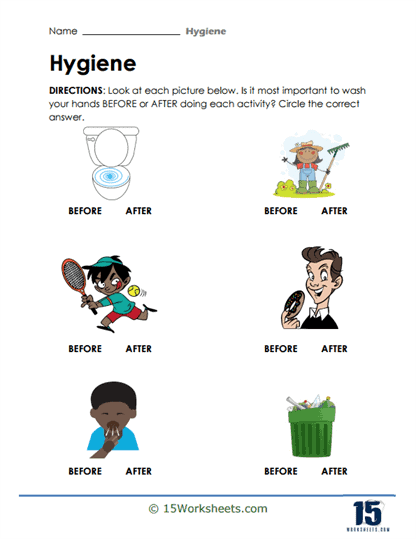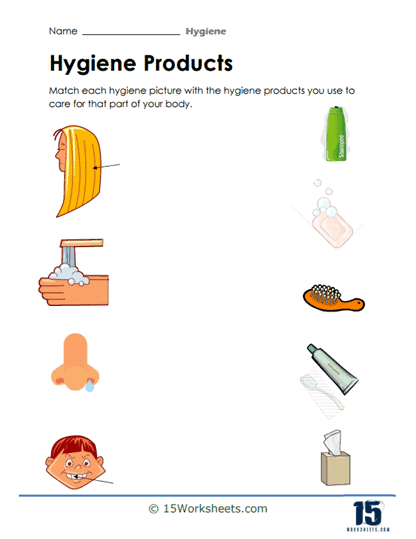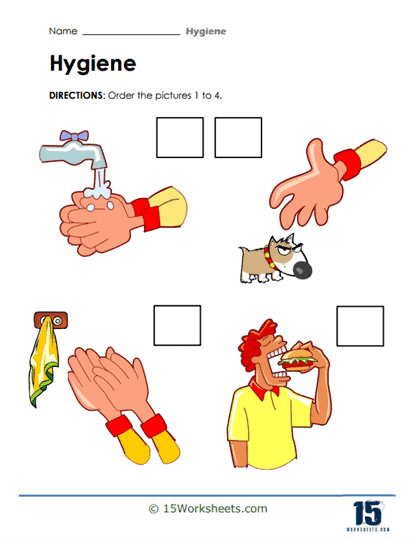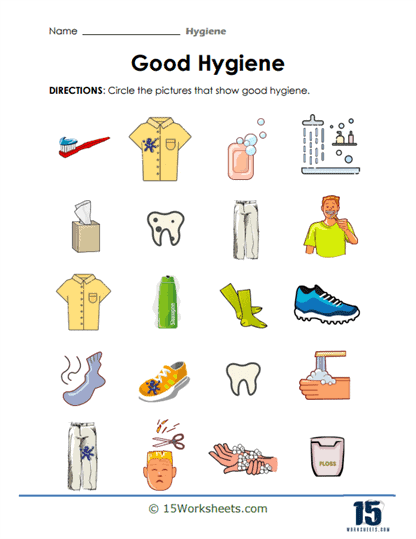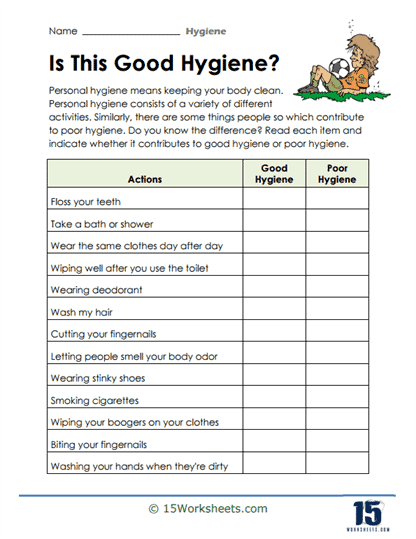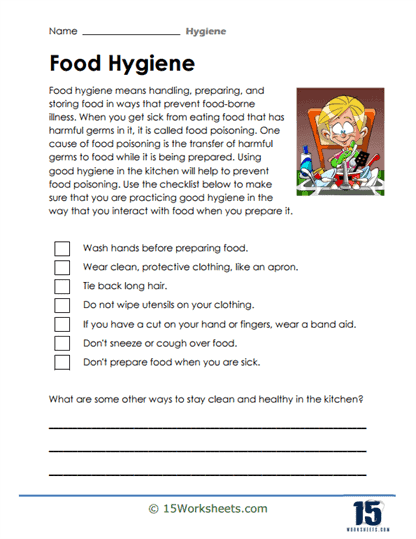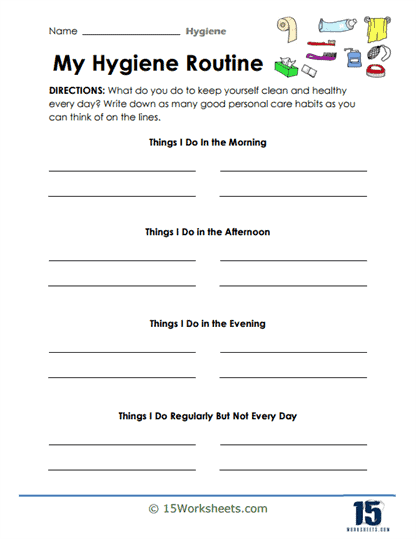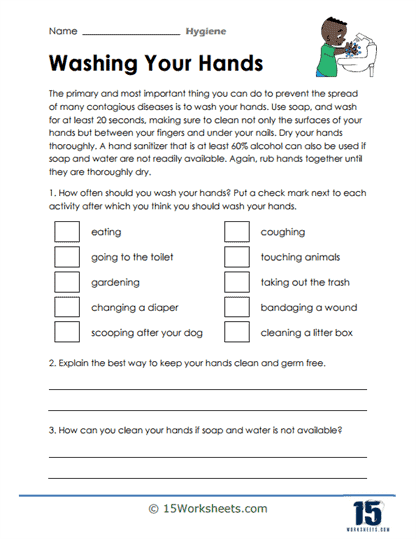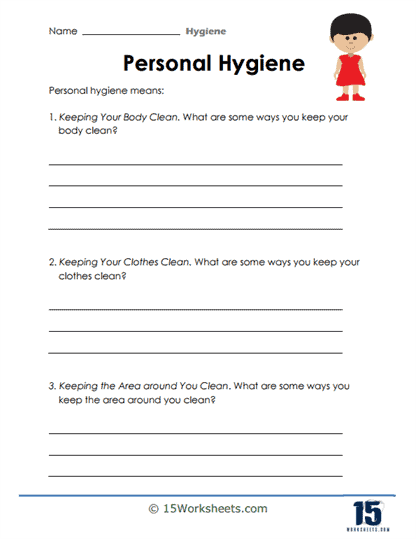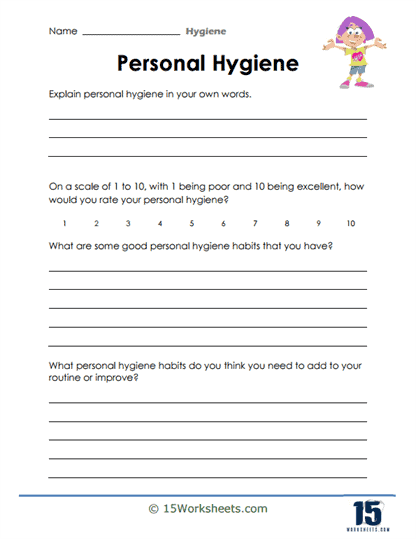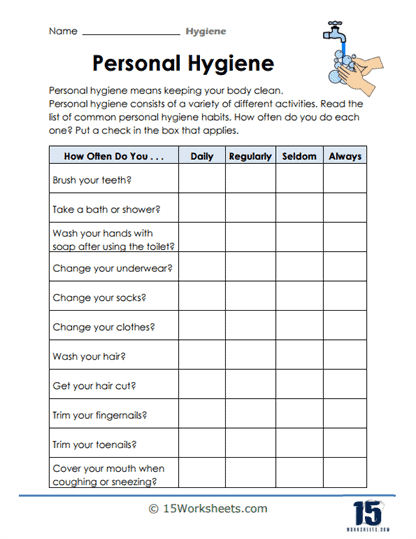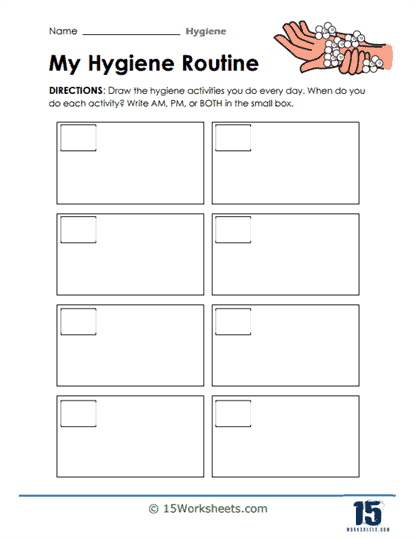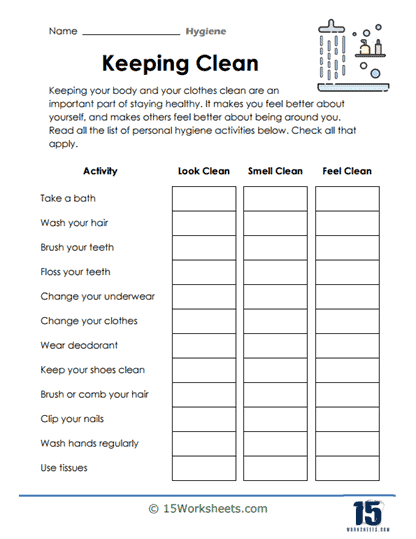Personal Hygiene Worksheets
All About These 15 Worksheets
This cadre of worksheets will help children better understand the importance of maintaining cleanliness and good hygiene habits. These worksheets focus on the basic principles of personal care, such as brushing teeth, washing hands, bathing, and grooming. They help children understand why hygiene is essential not only for staying healthy but also for feeling confident and comfortable in their daily lives. By using these worksheets, children can learn about the steps involved in various hygiene routines, and they begin to build habits that will benefit them throughout their lives.
Personal hygiene is especially important for young kids as they are developing their routines and habits that will last into adulthood. Teaching hygiene in a structured, fun, and interactive way through worksheets can make the learning process enjoyable and engaging. These worksheets often feature activities that are simple and relatable for young children, using illustrations, easy-to-understand language, and activities that reinforce healthy behaviors. They are a great resource for teachers, parents, and caregivers who want to instill good hygiene practices in children from an early age.
How Are These Helpful?
Personal hygiene worksheets are incredibly helpful for young children because they offer a hands-on and engaging approach to learning critical self-care routines. Hygiene might seem like a mundane topic, but when taught in a creative and interactive way, it can capture children’s attention and make learning fun. These worksheets help children grasp the importance of hygiene by visually illustrating its role in maintaining health, preventing illness, and promoting social well-being. For example, teaching kids why they need to wash their hands can be made more engaging by linking it to the idea of preventing the spread of germs and staying healthy.
The worksheets break down personal hygiene routines into manageable steps, which helps kids understand how to perform these tasks correctly. For example, brushing teeth, something that children often rush through, is broken down into steps: applying toothpaste, brushing for at least two minutes, cleaning each tooth surface, and rinsing thoroughly. By going through each step in detail, worksheets help children understand not only how to complete the task but also why it’s important to do it properly. This detailed approach encourages children to develop habits that ensure they are taking care of themselves effectively.
These worksheets build independence in children. As kids work through the activities, they learn to take responsibility for their hygiene without relying on constant reminders from adults. For instance, completing a worksheet on the proper way to wash hands helps children internalize the steps-wetting hands, applying soap, scrubbing for at least 20 seconds, and rinsing-that they can practice on their own. This sense of independence boosts their confidence and fosters self-care skills that are essential as they grow older.
Types of Exercises
Our personal hygiene worksheets feature a variety of exercises and activities designed to teach hygiene habits in an engaging way. One common type of exercise is step-by-step sequencing, where students are asked to put hygiene tasks in the correct order. For example, they might be given a set of images showing the steps for brushing teeth or washing hands, and they have to place them in the proper sequence. This type of activity helps reinforce the idea that hygiene routines follow specific steps and must be done correctly to be effective. It also makes learning visual and interactive, which is especially beneficial for younger children.
Another popular exercise is matching games where children are asked to match hygiene tools with their corresponding task. For example, a worksheet might show pictures of a toothbrush, a comb, soap, and a towel, and the child would need to match these items to activities like brushing teeth, combing hair, washing hands, or drying off after a bath. These exercises help children associate specific tools with hygiene practices, strengthening their understanding of how to care for themselves.
Fill-in-the-blank activities are also common in personal hygiene worksheets. These exercises may provide children with a sentence about a hygiene routine, such as “I wash my hands with ___,” and the child needs to fill in the correct answer, such as “soap.” This type of exercise not only reinforces key hygiene concepts but also helps with literacy and language development as children practice reading and writing. These activities also engage children cognitively, encouraging them to think about the items and actions associated with good hygiene practices.
In addition to sequencing and matching, many personal hygiene worksheets feature coloring pages or illustrated diagrams that children can label. For example, a diagram of a human body might be accompanied by labels such as “wash hands,” “brush hair,” “clean teeth,” and “take a bath,” with space for students to fill in the appropriate names or color-code the body parts that need care. These visual aids make learning about hygiene fun while also helping children understand the concept of taking care of their entire body.
Some worksheets include true or false questions or multiple-choice quizzes that test children’s understanding of basic hygiene rules. For instance, a worksheet might ask, “Should you wash your hands before eating?” or “How often should you brush your teeth?” These types of questions help children reflect on their daily habits and think critically about what they should be doing to maintain good hygiene. This format introduces kids to the idea of self-assessment, encouraging them to recognize areas where they may need to improve their hygiene practices.
Scenarios and problem-solving activities are another great tool found in personal hygiene worksheets. For example, a worksheet might present a scenario where a child has just finished playing outside and asks the student what hygiene steps should be taken next (e.g., washing hands, changing clothes). These exercises encourage kids to think about hygiene in a real-world context, preparing them to apply what they’ve learned in their daily lives.
How to Teach These Skills
Teaching personal hygiene is a vital part of helping children develop healthy habits that will support their overall well-being. Developing good hygiene practices early in life sets the foundation for lifelong health, confidence, and social comfort. But teaching these habits to kids requires patience, creativity, and consistency. Children often learn best through engaging and relatable activities, so making the process fun and interactive can greatly enhance their understanding. Let’s dive deeper into how to teach personal hygiene effectively and explore specific examples of how these tips can be implemented in a way that resonates with kids.
Start Early
Introducing personal hygiene to children at an early age is crucial because habits formed in childhood often carry into adulthood. When children learn the importance of handwashing, teeth brushing, and bathing from a young age, these routines become second nature. For example, as soon as children start participating in daily activities like playing outside or eating meals, parents and caregivers can begin teaching them to wash their hands before eating or after getting dirty. This early exposure familiarizes children with the concepts of cleanliness and creates an expectation of maintaining good hygiene.
Using simple tasks like reminding young children to brush their teeth every morning and evening or washing their hands after using the restroom helps instill these habits as part of their daily routine. Starting early also allows children to grow comfortable with the processes of self-care before they become self-conscious or resistant, ensuring that these hygiene habits become automatic.
Use Age-Appropriate Language
When explaining personal hygiene to kids, it’s important to use language that is age-appropriate and easy for them to grasp. Complicated explanations or technical terms can confuse young children and make hygiene tasks seem more daunting than they are. For instance, instead of saying, “Make sure you scrub the microorganisms off your hands,” you can simply say, “Wash your hands to get rid of the germs.” Using simple, clear language helps children understand the purpose behind the task, which increases their motivation to complete it.
Children are naturally curious, and when you explain hygiene in terms they can relate to, they are more likely to pay attention. For example, when teaching them to brush their teeth, you can tell a story about how “sugar bugs” love to hide in their mouths after they eat, and brushing helps get rid of these “bugs.” This playful explanation connects the idea to something tangible and makes the task less abstract.
Make It Fun
Turning hygiene lessons into something fun can significantly increase a child’s engagement and willingness to participate. Kids are far more likely to embrace personal hygiene practices if they associate them with enjoyable activities. Incorporating games, songs, and stories is a great way to make learning about hygiene exciting and memorable.
For example, you can create a simple handwashing song that lasts for 20 seconds, the recommended amount of time for washing hands. Singing the song each time children wash their hands can make the routine enjoyable, and kids will be more likely to remember the steps and timing. Similarly, you can turn brushing teeth into a game by using a timer to challenge children to brush for the full two minutes while listening to their favorite song. By adding an element of fun, hygiene becomes something children look forward to rather than a chore they need to complete.
Establish Routines
Establishing consistent daily routines for hygiene practices helps children remember and internalize these habits. Routines provide structure, making hygiene a natural part of the day. For example, brushing teeth in the morning and before bed, washing hands before meals, and taking a bath every night can be scheduled into the child’s day, so they know when each hygiene activity is expected.
Visual aids like a daily hygiene checklist or chart can be helpful tools in establishing routines. For example, a chart that lists “Brush Teeth,” “Wash Hands,” and “Take a Bath” as morning or evening tasks can act as a reminder and motivator for children. As they complete each task, they can place a sticker or checkmark next to the task, giving them a sense of accomplishment. Over time, these routines become ingrained in their behavior, making hygiene a natural part of their daily life.
Model Good Hygiene
Children learn a great deal from observing the behavior of adults around them, which is why modeling good hygiene is one of the most effective teaching methods. When children see parents or teachers practicing proper hygiene, they are more likely to imitate those behaviors. For instance, if children consistently see you brushing your teeth every morning and night, they will be more inclined to brush their own teeth at the same time. The same goes for washing hands after using the restroom or before meals.
To make this even more engaging, parents and caregivers can invite children to participate in hygiene tasks together. For example, parents can say, “Let’s wash our hands together before dinner,” or “We’re going to brush our teeth now, let’s do it at the same time.” This not only demonstrates good hygiene but also turns it into a bonding activity, making it something children look forward to rather than a solitary task.
Use Visual Aids
Visual aids like posters, charts, or picture books are excellent tools for reinforcing hygiene concepts with young children. These materials provide a visual representation of what proper hygiene looks like, making it easier for children to understand and remember the steps. For instance, a poster that illustrates the proper handwashing technique—showing how to apply soap, scrub all parts of the hands, and rinse—serves as a helpful reminder every time the child visits the sink.
Books and stories that feature characters practicing good hygiene can also be powerful tools. Stories about characters brushing their teeth, taking baths, or learning about germs can resonate with children and help them see hygiene as an important and even heroic part of their day. For example, a story about a superhero who fights germs by washing hands and brushing teeth can inspire children to follow suit.
Offer Positive Reinforcement
Encouraging children when they practice good hygiene reinforces the behavior and motivates them to keep up with healthy habits. Positive reinforcement, such as verbal praise, stickers, or small rewards, can make a big difference in encouraging consistent hygiene practices. For example, after a child successfully brushes their teeth on their own, a parent might say, “Great job! Your teeth are so clean now. Keep it up!” This kind of feedback builds confidence and lets the child know they are doing something important for their well-being.
Parents and teachers can also create reward systems where children earn a small treat or privilege for completing their hygiene tasks for the day. For instance, earning a star or sticker on a hygiene chart can lead to a special activity at the end of the week, reinforcing the importance of maintaining hygiene routines consistently.
Teach Proper Techniques
Teaching children the correct techniques for personal hygiene is essential to ensure that they are practicing effectively. Simply reminding kids to brush their teeth or wash their hands is not enough—they need to know how to do these things properly. For example, when teaching children how to brush their teeth, parents can show them how to brush all sides of the teeth, use a circular motion, and brush for the full two minutes.
Similarly, demonstrating proper handwashing techniques, including scrubbing between the fingers and under the nails for at least 20 seconds, ensures that children are not just going through the motions but are truly removing dirt and germs. Using simple language and breaking tasks into steps makes it easier for children to follow along and repeat these actions on their own.
Discuss the Consequences of Poor Hygiene
While it’s important to focus on the positive aspects of hygiene, children also need to understand the consequences of poor hygiene. Teaching kids about germs and how they spread helps them see why it’s essential to wash their hands, brush their teeth, and bathe regularly. Parents and teachers can explain how poor hygiene can lead to getting sick, having bad breath, or even losing friends because of unpleasant odors. However, this should be done in a gentle and age-appropriate way to avoid scaring children, but rather to help them see how hygiene keeps them and others healthy.
For instance, using visuals like germ-themed coloring pages or simple science experiments (such as growing bacteria on bread) can help children grasp how invisible germs work and how hygiene helps prevent sickness.
Be Patient
Finally, patience is key when teaching personal hygiene. Developing hygiene habits takes time, and children may need gentle reminders and repeated guidance as they learn. Some children might take to these routines quickly, while others may need more time to grasp the concepts. It’s important to be encouraging and to avoid frustration when children don’t get it right away.
By providing steady support, modeling good behavior, and offering positive reinforcement, children will eventually develop the confidence and independence they need to take responsibility for their own hygiene. With time and practice, these lessons will stick, and children will carry their good hygiene habits into adulthood, ensuring a lifetime of health and well-being.


